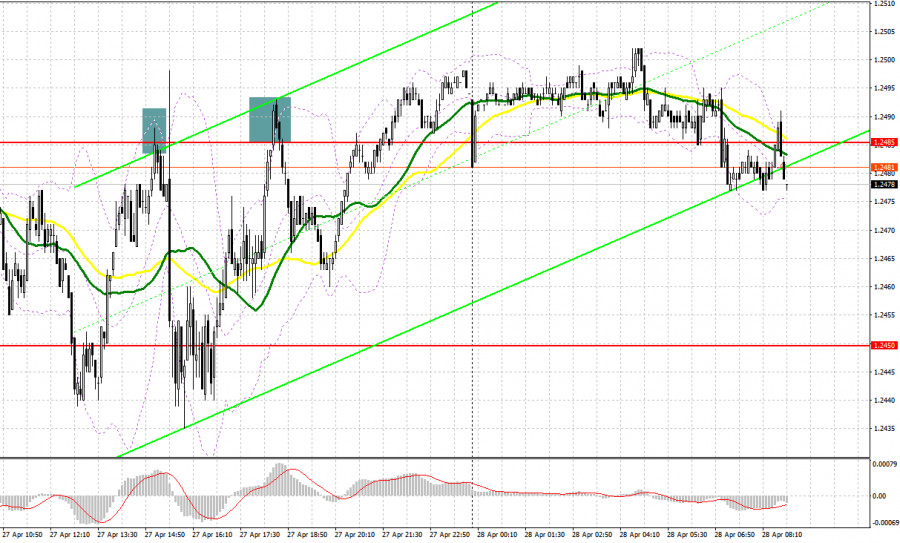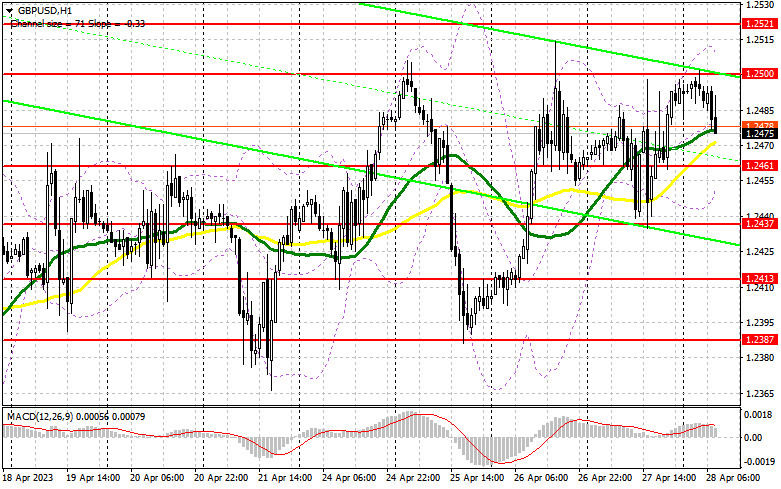
Yesterday, there were several entry points. Now, let's look at the 5-minute chart and figure out what actually happened. Earlier, I asked you to pay attention to the level of 1.2454 to decide when to enter the market. The fall and breakout occurred without a reverse test, so there was no buy signal. Likewise there was no proper consolidation and reverse test at 1.2454 upwards, so there was no sell signal. In the second part of the day a false breakout at 1.2485 gave a sell signal, after which the pound sank by more than 40 pips. By the end of the day, the bulls tried to climb above 1.2454, but it ended in failure.

Conditions for opening long positions on GBP/USD:
Considering that there is no fundamental statistics on the UK today, the pound bulls will have an excellent chance to return to the upper limit of the horizontal channel, but updating the monthly highs is unlikely at the end of the month. The focus will then shift to US inflation reports, which we will discuss during the US session.
The bulls must protect the intermediate support at 1.2461, formed yesterday. I believe that the optimal scenario is a fall and false breakout at this level, which will give a buy signal with the prospect of a jump to 1.2500, the upper limit of the horizontal channel. A false breakout and consolidation above this level will lead to another buy signal, with the prospect of surpassing 1.2511. A more distant target will be the level of 1.2543, this month's high, where I will take profit.
If the bulls fail to push the pair to 1.2461, above this level is where the moving averages which are benefiting bulls are passing, the pressure on the pound will return. In this case, I would advise you not to rush into purchases and open long positions only near the support level of 1.2437 and only after a false breakout. You could buy GBP/USD at a bounce from a low of 1.2413, keeping in mind an upward intraday correction of 30-35 pips.
Conditions for opening short positions on GBP/USD:
Bears have repeatedly proved their presence near 1.2500, but this level has already been tested three times, so it might not survive another strike. Although, it is the end of the month and week, so it is better for the bears. The bulls' inability to climb above 1.2500, as well as a false breakout will give a chance for the pound to regain the pressure, and a test of 1.2461, where the moving averages which are benefiting bulls are passing. A breakout and an upwards test will increase the pressure on the pound, creating a sell signal, the pound can fall to 1.2437. A more distant target will be the low of 1.2413, where I will take profit.
If GBP/USD rises and bears are not active at 1.2500, which is unlikely, I would advise you to postpone short positions until the test of the next resistance at 1.2515. Only a false breakout of this level will give an entry point into short positions. If there is no downward movement there, you could sell GBP/USD at a bounce from a high of 1.2543, keeping in mind a downward intraday correction of 30-35 pips.

COT report:
The COT report (Commitment of Traders) for April 11 logged a rise in long positions and a decline in short positions. The latest data on the UK gives traders hope for a further interest rate hike in the UK, which maintains interest in the pound. Considering that the aggressive policy of the Federal Reserve is coming to an end, and the Bank of England has no choice but to continue raising interest rates, fighting double-digit inflation, we can expect continued demand for the pound. A correction will be a good reason to enter long positions. According to the latest COT report, short non-commercial positions decreased by 3,882 to 57,326, while long non-commercial positions jumped by 8,513 to a level of 54,928. This led to a sharp reduction in the negative value of the non-commercial net position to -2,398 versus -14,793 a week earlier. The reduction has been happening for the third straight week, which also confirms the bullish nature of the market. The weekly closing price fell to 1.2440 from 1.2519.
Signals of indicators:
Moving Averages
Trading is performed above the 30- and 50-day moving averages, indicating that bulls are returning to the market.
Note: The author considers the period and prices of moving averages on the one-hour chart which differs from the general definition of the classic daily moving averages on the daily chart.
Bollinger Bands
In case of a decline, the lower limit of the indicator located around 1.2450 will act as support.
Description of indicators
Moving average (a moving average determines the current trend by smoothing volatility and noise). The period is 50. It is marked in yellow on the chart.Moving average (a moving average determines the current trend by smoothing volatility and noise). The period is 30. It is marked in green on the graph.MACD indicator (Moving Average Convergence/Divergence - convergence/divergence of moving averages). A fast EMA period is 12. A slow EMA period is 26. The SMA period is 9.Bollinger Bands. The period is 20.Non-profit speculative traders are individual traders, hedge funds, and large institutions that use the futures market for speculative purposes and meet certain requirements.Long non-commercial positions are the total number of long positions opened by non-commercial traders.Short non-commercial positions are the total number of short positions opened by non-commercial traders.The total non-commercial net position is a difference in the number of short and long positions opened by non-commercial traders.